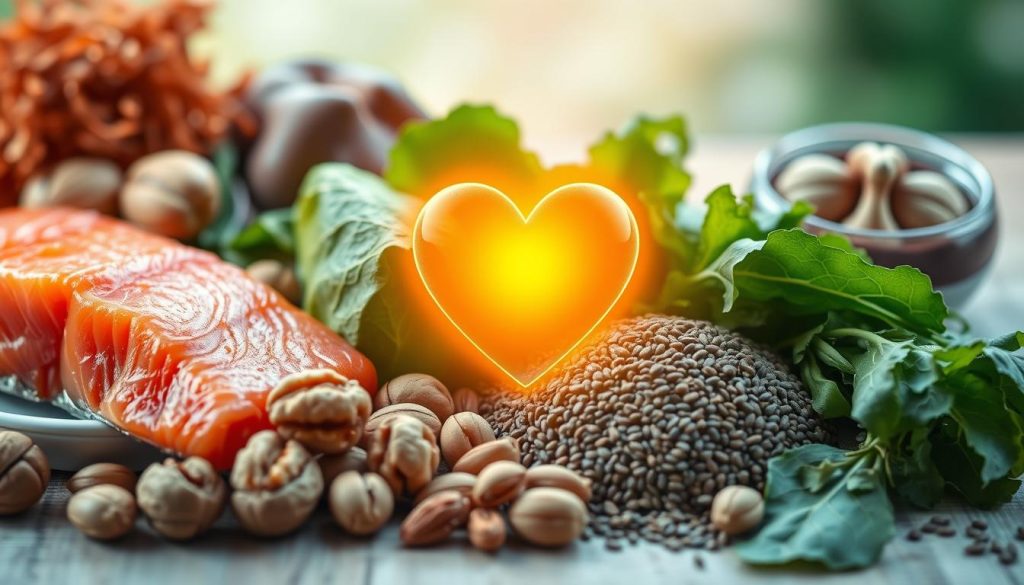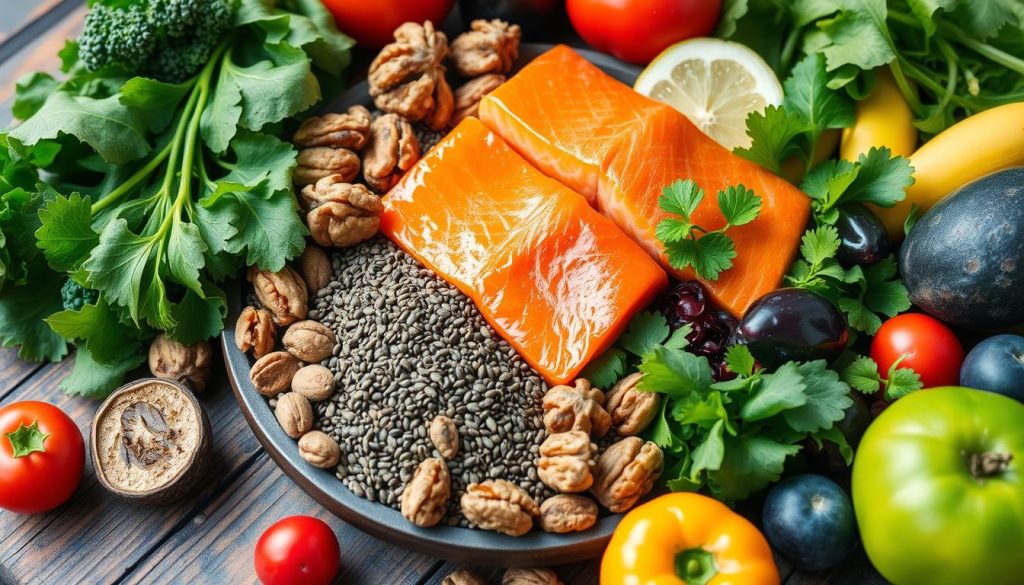Many foods are packed with omega-3 fatty acids, which are great for your body and brain. Eating certain fish, seeds, and nuts can boost your omega-3 intake. Health experts say adults should aim for 250–500 milligrams (mg) of EPA and DHA daily. This can be done by eating two servings of fatty fish each week.
You can also get lots of omega-3s from algae and some high-fat plant foods.
Key Takeaways
- Omega-3 fatty acids are essential for optimal health, supporting heart, brain, and overall body function.
- Fatty fish like salmon, mackerel, and sardines are rich sources of the omega-3s EPA and DHA.
- Plant-based omega-3s, such as those found in flaxseeds, chia seeds, and walnuts, provide the ALA form of omega-3.
- Incorporating a variety of omega-3-rich foods into your diet can help you meet your daily needs.
- Omega-3 supplements may not provide the same benefits as getting omega-3s from whole foods.
What Are Omega-3 Fatty Acids?
Omega-3 fatty acids are a special kind of fat that our bodies can’t make. We need to get them from food or supplements. They are vital for our health, and knowing about them helps us eat right.
Types of Omega-3 Fatty Acids
There are three main types of omega-3 fatty acids:
- Eicosapentaenoic acid (EPA) – Found in fatty fish and algae, EPA fights inflammation and keeps the heart healthy.
- Docosahexaenoic acid (DHA) – Also in fatty fish and algae, DHA is key for brain and eye health.
- Alpha-linolenic acid (ALA) – In plants like flaxseeds and walnuts, ALA can turn into EPA and DHA, but not much.
Benefits of Omega-3 Fatty Acids
Omega-3 fatty acids are good for many things, like:
- Helping the heart by lowering blood pressure and triglycerides
- Lessening body inflammation, which helps with arthritis and asthma
- Boosting brain function and memory
- Supporting eye and nervous system health
- Maybe even lowering cancer and Alzheimer’s risk
“Omega-3 fatty acids are essential for human health, but our bodies can’t make them. That’s why it’s so important to get them from our diets.”
Fatty Fish: Rich Sources of Omega-3
Fatty fish are top choices for increasing omega-3 intake. They are full of EPA and DHA, which are key for health.
Mackerel: A Nutrient-Dense Omega-3 Powerhouse
The mackerel stands out among fatty fish. It’s an omega-3 powerhouse with 4,580 mg of EPA and DHA per 3.5-ounce serving. Eating mackerel regularly helps meet your omega-3 needs and supports health.
Salmon: A Superfood Packed with Omega-3s
Salmon is another omega-3 superstar. It has 2,150 mg of EPA and DHA per 3.5-ounce serving. Salmon is a nutritional powerhouse. Adding salmon to your diet regularly can bring many health benefits.
Eating fatty fish like mackerel and salmon boosts omega-3 intake. They are delicious and nutritious, supporting your health and well-being.
Foods Rich in Omega-3 Fatty Acids
There are many foods high in omega-3 beyond fatty fish. Seafood like herring, sardines, and oysters are great sources. Plant-based options like flaxseed, chia seeds, and walnuts also offer a lot of omega-3 content. These foods are key to a healthy diet.
Oily fish like salmon and mackerel are packed with EPA and DHA. These omega-3s are good for your health. On the other hand, plant-based foods like flaxseeds and walnuts have ALA. Your body can turn ALA into EPA and DHA, but not as well as eating them directly.
Eating a variety of omega-3-rich foods is important. You can choose from seafood, nuts, seeds, or mix them. There are many tasty and healthy options to pick from.
| Food | Omega-3 Content |
|---|---|
| Salmon | 1.9 grams per 3.5 ounces |
| Mackerel | 3.0 grams per 3.5 ounces |
| Walnuts | 2.5 grams per 1 ounce |
| Chia seeds | 5.0 grams per 1 ounce |
| Flaxseeds | 6.3 grams per 1 ounce |
By eating a variety of omega-3-rich foods, you get all the essential fatty acids. This can lead to many health benefits.
Cod Liver Oil: A Concentrated Source of Omega-3
Cod liver oil is a special and rich source of omega-3 fatty acids. It offers a strong mix of these important nutrients. Unlike regular fish oils, cod liver oil comes from cod fish livers, making it more potent.
This oil is packed with eicosapentaenoic acid (EPA) and docosahexaenoic acid (DHA). These omega-3s are known for their health benefits.
Unlike regular fish oil, cod liver oil also has lots of vitamins A and D. Just one tablespoon of cod liver oil gives over 2,400 mg of EPA and DHA. This is why cod liver oil is known for supporting heart health, immune function, and brain function.
| Nutrient | Cod Liver Oil | Fish Oil |
|---|---|---|
| EPA | 9% | 18% |
| DHA | 14% | 12% |
| Vitamin A | Abundant | Minimal |
| Vitamin D | Abundant | Minimal |
While cod liver oil is generally safe in small amounts, it’s wise to talk to a doctor before starting it. Too much vitamin A and vitamin D can cause problems.
“Cod liver oil typically contains about 9% EPA and 14% DHA, whereas fish oil contains 18% EPA and 12% DHA.”
In summary, cod liver oil is a concentrated and special source of omega-3s. It’s a great choice for those looking to improve their health and wellness.
Plant-Based Omega-3 Sources
Fatty fish are known for their omega-3 content. But, there are plant-based options too. Flaxseed and chia seeds are great for boosting your omega-3 intake.
Flaxseed: A Versatile Omega-3 Option
Flaxseed is packed with omega-3 fat alpha-linolenic acid (ALA). It has 2,350 mg per tablespoon. This makes flaxseed a great addition to your diet.
You can sprinkle it on yogurt, cereal, or salads. Or add it to baked goods for extra nutrition.
Chia Seeds: Tiny but Mighty in Omega-3s
Chia seeds are a top source of plant-based omega-3s. They have 5,050 mg of ALA per ounce. These small seeds are perfect for smoothies, puddings, or as an egg substitute in vegan baking.
They’re great for vegetarians, vegans, and anyone wanting to mix up their omega-3 sources.
With plant-based options like flaxseed and chia seeds, getting enough omega-3s is easy. It doesn’t matter if you eat meat or follow a plant-based diet.
“Omega-3 fats in EPA and DHA play a critical role during pregnancy, breastfeeding, and childhood. They’re essential for brain, nerve, and eye development.”
Omega-3s and Heart Health
Omega-3 fatty acids, found in fatty fish, are good for your heart. Studies show they can lower cholesterol and triglycerides. This helps prevent heart disease.
Cardiovascular disease is a big killer in the US, with one death every 33 seconds. Omega-3s, like EPA and DHA, can cut down on triglycerides. This leads to fewer heart problems and deaths by 25% and 20%, respectively.
The Omega-3 Index is a measure of EPA and DHA in your blood. It should be over 8% to lower heart disease risk. The American Heart Association suggests eating fatty fish twice a week for heart health.
Dietary intake of omega-3 fatty acids has been linked to a reduced risk of coronary heart disease in women. The GISSI-Prevenzione trial showed omega-3s can lower heart attack risks. This is true for people who have had heart attacks before.
But, omega-3 supplements might not be as good for your heart. They could even increase heart rhythm problems. Eating foods rich in omega-3s is better for your heart.

There are three main types of omega-3s: EPA, DHA, and ALA. EPA and DHA are in fatty fish like herring and salmon. ALA is in plants like walnuts and flaxseed oil.
Omega-3s are great for your heart. They help with blood pressure, heart rate, and rhythm. They also improve blood vessel function and reduce inflammation. Adding these nutrients to your diet can help prevent heart disease and keep your heart healthy.
Foods rich in omega-3 fatty acids
Omega-3 fatty acids are vital for heart health and brain function. While fatty fish like salmon, mackerel, and tuna are well-known sources, many other foods can also help. These foods make up an omega-3-rich diet.
Pasture-raised eggs and omega-3-enriched eggs are great choices. The chickens’ diets affect the nutrients in their eggs. Meat and dairy from grass-fed animals also have more omega-3s than conventional ones.
Plant-based sources like hemp seeds, spinach, Brussels sprouts, and purslane offer some omega-3s. They may not have as much as fatty fish or flaxseed and chia seeds. Yet, they can contribute to a balanced, omega-3-focused diet.
| Food | Omega-3 Content (per serving) |
|---|---|
| Flaxseed oil | 7.27 grams |
| Chia seeds | 4.9 grams |
| Salmon (cooked) | 1.9 grams |
| Walnuts | 2.6 grams |
| Spinach (cooked) | 0.1 grams |
Eating a variety of omega-3-rich foods can help you meet your daily needs. This way, you can enjoy the health benefits of these essential fatty acids.
“Omega-3 fatty acids are essential for heart health, brain function, and overall well-being. Ensuring you get enough of these healthy fats from a variety of sources is key to maintaining optimal health.”
Incorporating Omega-3s into Your Diet
To get enough omega-3 fatty acids, add a variety of omega-3-rich foods to your meals. Plan your meals and make smart food choices. This way, you can easily increase your omega-3 intake and support your health.
Meal Planning Tips for Omega-3 Variety
Try to eat fatty fish like salmon, mackerel, or sardines at least twice a week. These fish are full of omega-3 fatty acids like EPA and DHA. These acids are good for your heart, brain, and joints.
You can also add plant-based omega-3 sources to your diet. Flaxseeds, chia seeds, and walnuts are great for getting the omega-3 fatty acid ALA.
- Sprinkle chia seeds or ground flaxseeds on your morning oatmeal, yogurt, or smoothie.
- Add walnuts to your salads, baked goods, or as a healthy snack.
- Use flaxseed oil or chia seed oil in your cooking and dressings.
By planning ahead and choosing a variety of omega-3-containing foods, you can boost your omega-3 intake. This supports your overall health and well-being.

Conclusion
Omega-3 fatty acids are key nutrients that help your heart and brain. You can find them in tasty foods like fatty fish, flaxseed, and chia seeds. Supplements like cod liver oil are also good sources.
Adding these foods to your diet is easy. It helps you get the omega-3s your body needs. This supports your health and well-being.
It’s important to eat a balanced diet with enough omega-3s. This can lower the risk of heart disease and other health issues. Omega-3s are vital for a healthy lifestyle.
By eating more omega-3 foods, you can feel the benefits. Try adding salmon, mackerel, flaxseed, and chia seeds to your meals. See how they improve your health and well-being.
FAQ
What are the main types of omega-3 fatty acids?
What are the health benefits of omega-3 fatty acids?
What are some of the best sources of omega-3 fatty acids?
How much omega-3 should I consume daily?
Can omega-3 supplements provide the same benefits as getting omega-3s from food?
How can I easily incorporate more omega-3 fatty acids into my diet?
Source Links
- https://blog.uvahealth.com/2024/02/07/foods-rich-in-omega-3-youll-actually-like/
- https://www.verywellhealth.com/foods-high-in-omega-3-8645715
- https://www.bhf.org.uk/informationsupport/heart-matters-magazine/nutrition/omega-3s-and-your-heart
- https://www.ncbi.nlm.nih.gov/books/NBK564314/
- https://medlineplus.gov/ency/patientinstructions/000767.htm
- https://www.healthline.com/nutrition/12-omega-3-rich-foods
- https://www.webmd.com/healthy-aging/omega-3-fatty-acids-fact-sheet
- https://www.aarp.org/health/healthy-living/info-2023/foods-high-in-omega-fatty-acids.html
- https://www.bbcgoodfood.com/health/nutrition/health-benefits-cod-liver-oil
- https://therastore.co/blogs/articles/fish-oil-or-cod-liver-oil-understand-the-differences?srsltid=AfmBOordnqkYbwMIYKRT4B4w1ZGG3-cEjbOY6MgdreepIU_CmU7HCTrX
- https://www.youtheory.com/blogs/learn/plant-based-sources-of-omega-3s?srsltid=AfmBOoqhibhSs8AYMhKv4liN6fnJfnul7VEchPLzQfKqlcMGC5AS30UP
- https://www.vegansociety.com/sites/default/files/uploads/downloads/Omega-3_download.pdf
- https://www.rupahealth.com/post/omega-3-fatty-acids-in-cardiovascular-health-a-functional-medicine-guide
- https://www.cnet.com/health/nutrition/reap-the-benefits-of-omega-3s-with-these-heart-healthy-foods/
- https://www.healthline.com/nutrition/optimize-omega-6-omega-3-ratio
- https://blog.algaecal.com/omega3-omega6-chart/
- https://www.verywellhealth.com/omega-3-fatty-acids-8660468
- https://www.pdxfootandankle.com/blog/omega-3-fatty-acids-and-joint-health-benefits-and-sources-40772.html
- https://www.rupahealth.com/post/the-power-of-omega-3s-incorporating-healthy-fats-into-your-diet
- https://www.healthline.com/nutrition/7-plant-sources-of-omega-3s
- https://proveg.org/five-pros/pro-health/are-you-getting-enough-omega-3-fatty-acids-in-your-diet/
- https://fjps.springeropen.com/articles/10.1186/s43094-024-00667-5











































Discussion about this post